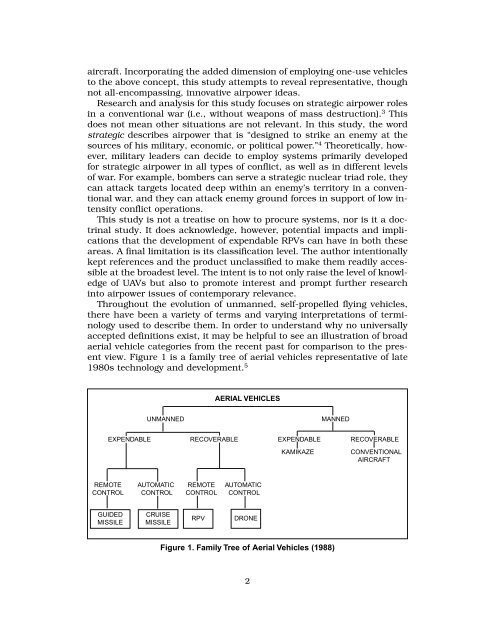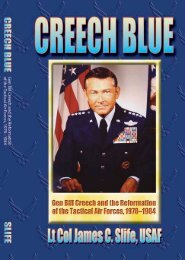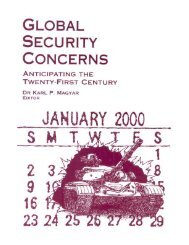Expendable Remotely Piloted Vehicles for Strategic Offensive ...
Expendable Remotely Piloted Vehicles for Strategic Offensive ...
Expendable Remotely Piloted Vehicles for Strategic Offensive ...
Create successful ePaper yourself
Turn your PDF publications into a flip-book with our unique Google optimized e-Paper software.
aircraft. Incorporating the added dimension of employing one-use vehiclesto the above concept, this study attempts to reveal representative, thoughnot all-encompassing, innovative airpower ideas.Research and analysis <strong>for</strong> this study focuses on strategic airpower rolesin a conventional war (i.e., without weapons of mass destruction). 3 Thisdoes not mean other situations are not relevant. In this study, the wordstrategic describes airpower that is “designed to strike an enemy at thesources of his military, economic, or political power.” 4 Theoretically, however,military leaders can decide to employ systems primarily developed<strong>for</strong> strategic airpower in all types of conflict, as well as in different levelsof war. For example, bombers can serve a strategic nuclear triad role, theycan attack targets located deep within an enemy’s territory in a conventionalwar, and they can attack enemy ground <strong>for</strong>ces in support of low intensityconflict operations.This study is not a treatise on how to procure systems, nor is it a doctrinalstudy. It does acknowledge, however, potential impacts and implicationsthat the development of expendable RPVs can have in both theseareas. A final limitation is its classification level. The author intentionallykept references and the product unclassified to make them readily accessibleat the broadest level. The intent is to not only raise the level of knowledgeof UAVs but also to promote interest and prompt further researchinto airpower issues of contemporary relevance.Throughout the evolution of unmanned, self-propelled flying vehicles,there have been a variety of terms and varying interpretations of terminologyused to describe them. In order to understand why no universallyaccepted definitions exist, it may be helpful to see an illustration of broadaerial vehicle categories from the recent past <strong>for</strong> comparison to the presentview. Figure 1 is a family tree of aerial vehicles representative of late1980s technology and development. 5AERIAL VEHICLESUNMANNEDMANNEDEXPENDABLE RECOVERABLE EXPENDABLE RECOVERABLEKAMIKAZECONVENTIONALAIRCRAFTREMOTE AUTOMATIC REMOTE AUTOMATICCONTROL CONTROL CONTROL CONTROLGUIDEDMISSILECRUISEMISSILERPVDRONEFigure 1. Family Tree of Aerial <strong>Vehicles</strong> (1988)2






